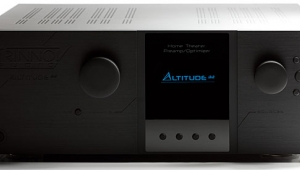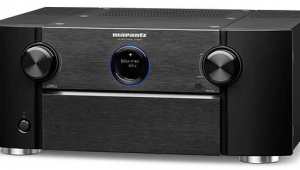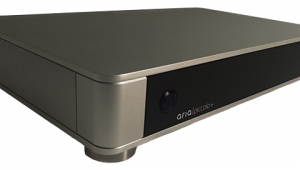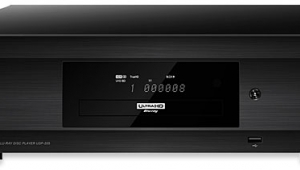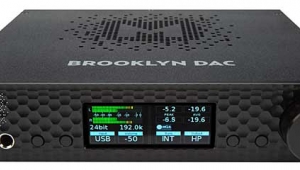| Columns Retired Columns & Blogs |
Music in the Round #15
In the past few installments of this column I've promised to talk about another subwoofer equalizer system. Now I'm going to pull the old switcheroo and discuss a different subwoofer EQ. The SMS-1 is a new, standalone digital equalizer system from Velodyne, based on the EQ built into their DD-series subwoofers. Larry Greenhill went gaga over the Velodyne DD-18 in the June 2004 Stereophile, particularly because of the ease and sophistication of the EQ system. Apparently, one of the Velodyne sales guys asked the obvious: What about making the EQ available separately for use with other subwoofers?
Footnote 1: For reasons still unclear, my two samples of the Onix R-DES generate whopping levels of noise in my system when asked to do any equalization. Searches of the AV123 Forums have failed to turn up any complaints from other users, so I've concluded that the problem is with my laptop, my audio system, or me. I hope to soon find out which, correct it, and report on the R-DES.
Why is this important? As someone who is still in the midst of fussing with room treatments, I well know that acoustics can be a cruel science. The very dimensions of a listening room impose their imprint on the sound, and any passive acoustical treatments to counteract those effects must be on the same physical scale. That means, first, that low-frequency peaks and nulls can be dealt with only by large devices; and second, that such devices are usually incompatible with domestic tranquility unless you're building or rebuilding a dedicated listening room, or like to live alone. The RealTraps, which I described in January, worked great, but the additional units needed to fix my room's sub-100Hz range were vetoed by A Higher Authority.
So what's a guy to do? There are expensive solutions out there, such as the digital TacT and analog Rives systems. With multichannel sound, however, all the low frequencies that will be most affected by room modes are usually channeled through the subwoofer(s). In the single-channel, low-frequency-only world of subwoofers, the demands of sampling rate, frequency response, and transparency are much reduced. Below, say, 200Hz, the electrical engineering gets easier and cheaper even as the acoustical engineering gets cumbersome. As I reported in this column in January, ACEI's little Subwoofer Optimizing System is a simple step in the right direction: it finds a single room mode and autocorrects it.
The four-band (plus high-pass and low-pass), filtering Onix R-DES looks like a comer (footnote 1), but its measurement side has yet to be automated. Behringer's inexpensive Bass Feedback Destroyer Pro DSP1124P (BFD), while designed for stage audio systems, is enormously flexible and has gathered quite a following from the hands-on contingent, especially with support for it in RoomEQWizard. However, both of these require extra equipment, such as a sound level meter and/or a PC. The ideal would be a single-channel, standalone system with the analysis and correction of the TacT and Rives devices but with a narrower bandpass and a much lower price.

Look, Ma, no PC!
Enter the Velodyne SMS-1 ($699). This little box is at once an equalizer to be connected between preamplifier-processor and subwoofer, a test-signal generator to be connected to a pre-pro's line input, a display device to be connected via composite or S-video to your monitor, and all the interactive computation power needed. A measurement microphone, mike stand, cables, and remote control for all operations are provided. Bruce Hall, president of Velodyne, brought over a beta model, and we hooked it up in less than 15 minutes. Not only that, but even with his running tutorial discussion, we accomplished some pretty impressive results with my Paradigm Servo-15 subwoofer in less than half an hour.
The SMS-1 can display three menus. Through these, the user controls all operations from the remote control. The Introductory screen tells you that the SMS-1 is working, which of the stored presets is currently in effect, and permits you to select a preset, adjust subwoofer volume, or enter the setup mode. The EQ Setup menu is used in the analysis and EQ mode. As the SMS-1 pipes repetitive low-frequency sweeps into your system, this menu displays the frequency response. Each sweep takes only a few seconds, so you can move speakers or subs and fiddle with crossover and bass management to see how they change the response. Bruce Hall recommends looking at the responses of the main speakers and subwoofer (in my case, Paradigm's Studio/60 v.3 and Servo-15) separately and together, in order to see which parts of the overall response are due to each and which to the room.
We next went to the System Settings menu to adjust the low-pass filter, subwoofer level, and subwoofer polarity to best match the main speakers and to minimize any peak or null at the crossover point between the speakers and the sub. After this, we tweaked the subwoofer phase and the SMS-1's low-pass filter to further smooth the response. The result—and this was before any actual EQ—was a fairly flat trend line from 200Hz down to 15Hz, though there were considerable bumps and troughs along the way.
Back at the EQ Setup menu, the user has two ways to set EQ. He can let the Auto-EQ feature iteratively adjust each of eight filters while watching its progress on the screen. These filters have a range of +6dB to –12dB and, initially or for Auto-EQ, are set at 20, 25, 32, 40, 50, 63, 80, and 100Hz. After 25 iterations, Auto-EQ reduced the range of variation but failed to get the ±3dB envelope promised by the manual; visible irregularities remained in the response. Still, a quick audition of this outcome, A/B'd with the SMS-1's Bypass mode, was a clear improvement.
Flat-out corrected
One of the advantages of manually setting the EQ filters, in addition to abetting a descent into obsessive madness, is the option to shift the center frequency (F0) and tweak the Q (Quality Factor, or sharpness) of each filter so it will do the most good. This might even involve superimposing high-Q and low-Q filters at the same F0 to correct a complex anomaly. You can always switch over to actually listening to music while adjusting the controls, but I found that the visual feedback was more useful than the auditory, at least in the short term. After all, the things you want to hear at the bass end of the music are often elusive and fleeting, but a visibly flat response is a flat response. Besides, the multiple EQ setup options give you plenty of opportunity to listen to different corrections with music and without the distractions of displays.

When we'd finished those adjustments (I refined them again after Hall's departure), we locked them into Setup memory. Hall then explained how the SMS-1 can store and recall five presets in addition to the flat one, permitting you to have several "house curves" for specific applications. Want a subsonic filter and a slightly rising sub-80Hz response for most movies? Want to goose the sub-30Hz octave for those explosions in action-adventure movies? Want to enrich the octave around 100Hz to really energize rock and pop recordings? Mebbe you just like it flat for jazz and classical? You want it, you got it with the push of a button on the remote.
I like it pretty flat most of the time, for music of all kinds. My Paradigm Servo-15 sub is plenty big enough to load my small room, and I've been timid with it in the past. Part of the reason is that the room seems to dictate a wide null in the 50Hz region between modes in the 35Hz and 75Hz regions. Without any correction, raising the Servo-15's level could not fill the gap, and lowering it sapped the bass completely. Even the auto-correction of the ACEI SOS dealt only with the 75Hz mode. In addition, measurements at these frequencies are very sensitive to the position of the microphone, so I measured and corrected for several positions before arriving at a consensus setting. This meant that there was now a mild rise around 50Hz when I leaned far back at leisure; at a more attentive listening posture it gave me a pretty good correction.

The SMS-1 seemed to have done the trick for the ear as well as for the eye. Bass levels were now commensurate with the rest of the spectrum, and while the subwoofer level was now higher, the bass was less prominent most of the time, but with much more detail and resolution. Even solo violin (!) benefited from the enhancement of ambience, which I could now distinguish more clearly from the instrument's direct sound. What I was probably hearing was more of the ambience of the recording venue and less of my room's sonic signature.
Footnote 1: For reasons still unclear, my two samples of the Onix R-DES generate whopping levels of noise in my system when asked to do any equalization. Searches of the AV123 Forums have failed to turn up any complaints from other users, so I've concluded that the problem is with my laptop, my audio system, or me. I hope to soon find out which, correct it, and report on the R-DES.
- Log in or register to post comments


